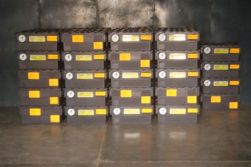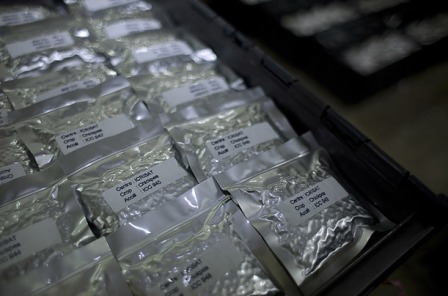CGKB News and events Chickpea
Safety duplication of cultivated chickpea and wild relative genetic resources
Contributors to this page: ICRISAT, Patancheru, India (Hari D Upadhyaya, Shivali Sharma, Cholenahalli L Laxmipathi Gowda, Dintyala Sastry, Sube Singh); NBPGR, New Delhi, India (Shyam Sharma); ICARDA, Aleppo, Syria (Ahmed Amri, Kenneth Street, Natalya Rukhkyan), SARC-RIPP, Piestany, Slovak Republic (Gabriela Antalikova); Institute of Plant Genetic Resources ‘K.Malkov’, Sadovo, Bulgaria (Siyka Stoyanova); Department of Primary Industries, Victoria, Australia (Bob Redden); IPK, Gatersleben, Germany (Andreas Börner).
When should it be used
- When the original accessions are lost and no longer available and safety back-up storage is the only source for regenerating the accessions.
- To replace active/base collections, when germination is very low or nil.
- Should be located in a different country.
See also the general page on safety duplication procedures.
|
|
| Samples for safety duplication (photo: ICRISAT) |
Sample specifications
Following procedures in the Genebank Manual of ICRISAT (Upadhyaya and Laxmipathi, 2009).
Minimum sample size for storage
- Cultivated species: 100 g of seeds.
- Wild Cicer species: 200 seeds.
Viability for storage
- Cultivated species: seeds with 85% viability or more.
- Wild Cicer species: seeds with 80% viability or more.
Moisture content
- 5-7% (FAO/IPGRI standards).
Container specifications
To ensure seed viability in the genebank and en route to the users.
Specifications of packaging material
Follow procedures of the ICRISAT Genebank Manual (Upadhyaya and Laxmipathi, 2009) and FAO/IPGRI standards.
- Use three-layered standard aluminum foil packets consisting of the following layers:
- Polyester 17 g/m2 (an outer layer of 17 g Melinex and 4 g lacquer).
- Alufoil 33 g/m2 [a middle layer of 33 g (12 mm) aluminum foil and 4 g lacquer].
- Polyethylene 63 g/m2 (an inner layer of 63 g polyethylene).
- Use a packet size of 140x160 mm for holding an approximate seed quantity of 100 g.
Seed packaging method
Follow procedures of the ICRISAT Genebank Manual (Upadhyaya and Laxmipathi, 2009).
- Prepare and label the aluminum foil packets with computer generated self-adhesive labels with the accession number, identity and season of harvest.
- Take out only a few samples at the time from the drying room to minimize re-absorption of moisture by seeds.
- Weigh the amount of seed prepared for storage and fill the container with seeds having at least 2.5 cm headspace for labeling.
- Place a non-adhesive label with accession number, identity and season of harvest inside the packet.
- Seal the container using a standard vacuum sealer.
- Check for any deficiencies in packets and sealing.
- Print the date of sealing on the packet and move the samples to the long-term store.
Storage specifications
Assigning location codes in boxes
- Black-box storage based on the facilities of the centre holding the duplicate collection (e.g. in the case of ICRISAT, ICARDA seed storage location code practices).
- Use a barcode system (Genebank Information Management System, GIMS).
|
|
| Chickpea samples at the svalbard seed vault (photo: ICRISAT) |
Storage conditions
- Black-box storage at -18 to -22ºC (FAO/IPGRI standards).
- As per the Svalbard Seed Deposit Guidelines.
Shipping method
Should be safe, less costly and fast enough to avoid delays and deterioration of seed quality during transfer.
- Preferably by air-freight to the nearest destination (following international shipment practices for perishable goods).
Legal arrangements
The Centre, host country and importing centre and country policies and practices for germplasm movement for black-box storage, must be fulfilled:
- MOU for safety back-up.
- Special agreement for Svalbard.
- Certificate of origin.
- Certificate of no-commercial value.
- GMO-free certificate.
- Import permit.
- Phytosanitary certificate.
- Customs clearances.
- Others.
See also the link to the safety duplication strategies on this site, for more details.
Recording information during safety duplication
For large genebanks with active, base and safe duplication strategies, the following alternative is recommended (ICARDA Model):
- Flag of safety duplication status (Y/N).
- Number of seeds.
- Weight of seeds.
- Year of production of seeds.
- Year of safety duplication.
- Name of institute holding the safety duplicate(s).
- Box label where the sample is placed.
- Common steps (regardless of conservation strategy).
References and further reading
FAO/IPGRI. 1994. Genebank standards. Food and Agriculture Organization of the United Nations, Rome and International Plant Genetic Resources Institute, Rome. Available in English, Spanish, French and Arabic.
Nordgen. 2008. Agreement between (depositor) and the Royal Norwegian Ministry of Agriculture and Food concerning the deposit of seeds in the Svalbard Global Seed Vault. [online] The Svalbard Gloal Seed Vault, The Nordic Genetic Resource Centre, ALNARP. Available from: http://www.nordgen.org/sgsv/scope/sgsv/files/SGSV_Deposit_Agreement.pdf.
Upadhyaya HD, Laxmipathi Gowda CL. 2009. Managing and Enhancing the Use of Germplasm – Strategies and Methodologies. Technical Manual no. 10. Patancheru 502 324, Andhra Pradesh, India: International Crops Research Institute for the Semi-Arid Tropics. 236 pp.
Conservation of chickpea genetic resources
Contributors to this page: ICRISAT, Patancheru, India (Hari D Upadhyaya, Shivali Sharma, Cholenahalli L Laxmipathi Gowda, Dintyala Sastry, Sube Singh); NBPGR, New Delhi, India (Shyam Sharma); ICARDA, Aleppo, Syria (Ahmed Amri, Kenneth Street, Natalya Rukhkyan), SARC-RIPP, Piestany, Slovak Republic (Gabriela Antalikova); Institute of Plant Genetic Resources ‘K.Malkov’, Sadovo, Bulgaria (Siyka Stoyanova); Department of Primary Industries, Victoria, Australia (Bob Redden); IPK, Gatersleben, Germany (Andreas Börner).
Importance of chickpea conservation
Archeological chickpea remains found from Syria to Greece dating from the very early days of farming show its important role in the dispersal of farming habits. Like many other crops, it has been subjected to different selection pressures in various ecological and cultural environments and consequently diversified into a range of varieties. It is likely that chickpea has a higher potential to yield more than the yields currently achieved on farmers' fields. This potential can only be fully utilized if a broad range of genetic materials are available to select from or to breed for specific traits. Therefore, breeding for higher and more stable yields and also for enhanced resistance to pests and diseases is one of the immediate objectives of many chickpea programmes.
- A more efficient and effective conservation of the chickpea genepool worldwide, including both cultivated and wild species, is essential and potentially very important for research and crop improvement.
- Some of the wild relatives are potentially important to incorporate resistance to abiotic and biotic stresses.
- Tolerance to drought is a particularly important trait for chickpea that often grows in extremely harsh and dry environments.
- Priority should be given to conservation of chickpea in primary and secondary centres of diversity.
- Urgent priorities identified for chickpea conserved in many genebanks are the need for regeneration, characterization, safety duplication and long-term conservation.
- Cicer genetic resources could be much better utilized if a representative core collection (10% of the entire collection) and a mini core collection (10% of the core or 1% of entire collection) are developed and evaluated extensively for useful traits.
- More data is available at the accession level for economic traits to identify trait-specific germplasm.
- Many small collections contain unique materials that can be extremely important for the genetic improvement of the crop.
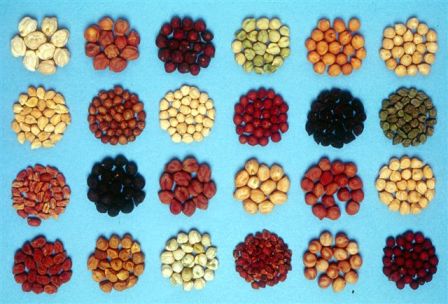 Chickpea seed diversity (photo: ICRISAT) |
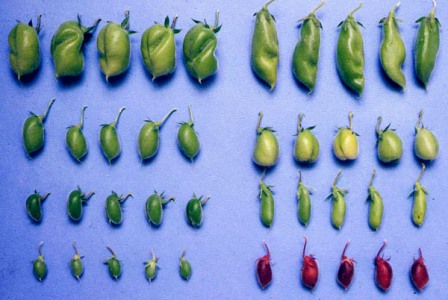 Chickpea diversity of pods (photo: ICRISAT) |
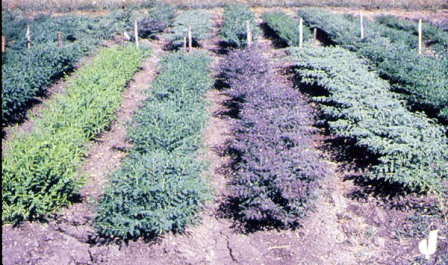 Chickpea germplasm diversity in the field (photo: ICRISAT) |
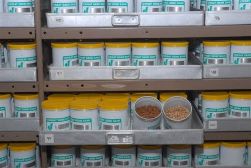
A chickpea genebank (photo: ICRISAT) |
Major chickpea collections
Chickpea collections include landraces, breeding material and wild species. It is estimated that more than 80 000 accessions are conserved in more than 30 genebanks worldwide. The genebank at ICRISAT Patancheru, India, is one of the largest genebanks holding >20 000 accessions of chickpea from 60 countries. Other major collections (more than 5000 accessions) are held at NBPGR, New Delhi, India; ICARDA Aleppo, Syria; Australian temperate field crops collection, Victoria, Australia; USDA, USA and the Seed and Plant Improvement Institute, Iran.
It was only after 1970 that wild Cicer species were actively collected. Currently there is a reasonable number of wild annual species but still limited availability of perennial species. Less than 1% of the Cicer accessions (conserved in about tengenebanks worldwide) represent wild species. The ICRISAT genebank holds 308 accessions belonging to 18 species of wild Cicer from 14 countries.
References and further reading
Abbo S, Redden RJ, Yadav SS. 2007. Utilization of wild relatives. In: Yadav SS, Redden R, Chen W, Sharma B, editors. Chickpea Breeding & Management. CABI, Wallingford, UK. pp 338-354.
Chickpea [online]. Available from URL: http://www.icrisat.org/crop-chickpea.htm. Date accessed: 29 January 2010.
FAO/IPGRI. 1994. Genebank standards. Food and Agriculture Organization of the United Nations, Rome and International Plant Genetic Resources Institute, Rome. Available in English, Spanish, French and Arabic.
Global Crop Diversity Trust. 2008. Global strategy for the ex situ conservation of chickpea (Cicer L.) [online]. Available from: http://www.croptrust.org/documents/web/CicerStrategy_FINAL_2Dec08.pdf. Date accessed: 25 May 2009.
IBPGR, ICRISAT, ICARDA. 1993. Descriptors for Chickpea (Cicer arietinum L.). International Board for Plant Genetic Resources, Rome, Italy; International Crops Research Institute for the Semi-Arid Tropics, Patancheru, India and International Center for Agricultural Research in the Dry Areas, Aleppo, Syria. ISBN 92-9043-137-7. Available here.
ICRISAT Chickpea Germplasm Collection Reports. Genetic Resources Unit, International Crops Research Institute for the Semi-Arid Tropics, Patancheru, A.P. 502 324, India. GRU - Progress Reports – 20 no’s.
ICRISAT Chickpea collection. SINGER [online]. Available from http://www.singer.cgiar.org/index.jsp?page=showkeycount&search=coc=co38. Date accessed: 30 January 2010.
Hanson J. 1985. Procedures for handling seeds in genebanks. Practical manuals for genebanks no. 1. International Board for Plant Genetic Resources. http://www.bioversityinternational.org/index.php?id=19&user_bioversitypublications_pi1[showUid]=2235.
Jambunathan R, Singh U, Subramanian V. 1981. Grain quality of sorghum, pearl millet, pigeonpea and chickpea. In: Proceedings of a workshop held at International Crops Research Institute for the Semi-Arid Tropics, Patancheru-502 324, Andhra Pradesh, India.
Singh KB, Pundir RPS, Robertson LD, van Rheene HA, Singh U, Kelley TJ, Rao PP, Johansen C, Saxena NP. 1997. Chickpea. In: Fuccillo D, Sears L, Stapleton P, editors. Biodiversity in Trust. Cambridge University Press. pp. 100-113.
Rao NK, Hanson J, Dulloo ME, Ghosh K, Nowel D, Larinde M. 2006. Manual of seed handling in genebanks. Handbooks for Genebanks No. 8. Bioversity International, Rome, Italy. Available in English (1.5 MB), Spanish (1.4 MB) and French (1.9 MB).
Redden B, Furman BJ, Upadhyaya HD, Pundir RPS, Gowda CLL, Coyne C, Enneking D. 2007. Biodiversity Management in Chickpea. In: Yadav SS, Redden R, Chen W, Sharma B, editors. Chickpea Breeding & Management. CABI, Wallingford, UK. pp 355-368.
Upadhyaya HD, Gowda CLL, Sastry DVSSR. 2008. Management of germplasm collections and enhancing their use by mini core and molecular approaches. APEC-ATCWG Workshop. Capacity building for risk management systems on genetic resources. pp. 35-70. http://www.tari.gov.tw/taric/uploads/publication_no135_08.pdf.
Upadhyaya HD, Gowda CLL, Sastry DVSSR. 2008. Plant genetic resources management: collection, characterization, conservation and utilization. Journal of SAT Agricultural Research 6. http://www.icrisat.org/Journal/Volume6/ChickPea_PigeonPea/HD_Upadhyaya.pdf.
Upadhyaya HD, Laxmipathi Gowda CL. 2009. Managing and Enhancing the Use of Germplasm – Strategies and Methodologies. Technical Manual no. 10. Patancheru 502 324, Andhra Pradesh, India: International Crops Research Institute for the Semi-Arid Tropics. 236 pp.
Registration of cultivated chickpea and wild relatives genetic resources
Contributors to this page: ICRISAT, Patancheru, India (Hari D Upadhyaya, Shivali Sharma, Cholenahalli L Laxmipathi Gowda, Dintyala Sastry, Sube Singh); NBPGR, New Delhi, India (Shyam Sharma); ICARDA, Aleppo, Syria (Ahmed Amri, Kenneth Street, Natalya Rukhkyan), SARC-RIPP, Piestany, Slovak Republic (Gabriela Antalikova); Institute of Plant Genetic Resources ‘K.Malkov’, Sadovo, Bulgaria (Siyka Stoyanova); Department of Primary Industries, Victoria, Australia (Bob Redden); IPK, Gatersleben, Germany (Andreas Börner).
Rationale for registration
Registration is done to allow the genebank curator to keep a record of samples held in the genebank and to produce inventory lists for conservation, distribution and other aspects of germplasm management.
- Each sample should have assigned a unique accession number which distinguishes it from all other accessions in the genebank.
- Samples should be registered when first entering the genebank.
Verifying accompanying documentation
Basic documentation is essential to track germplasm material. Health and IPR certificates are very important for entry to the country. The following documents should accompany each consignment of plant germplasm and should be recorded (using a Genebank Information Management System, GIMS):
- Standard Material Transfer Agreement (SMTA) and /or Germplasm Acquisition Agreement (GAA), whose status with regard to conservation and use is clearly defined.
- Phytosanitary certificate from donor.
- Plant import permit.
- GMO-free certificate.
- List of material.
- Seed source.
- Associated passport data, preferably in the Multi-crop Passport Descriptors (MCPD) format, preferably electronically.
Verifying the consignment
Checking the content
- Arrange the material received by the genebank according to alphabetical order of names of variety, or numeric order of number, depending on the identification provided on the packets/bags.
- Check all the packets as per the list provided with the samples.
- Prepare a new list if details are not provided with the samples.
- Request any missing passport information.
Checking the genebank
- Check the passport database file or collector's number and other information to ensure that the sample does not already exist in the genebank.
- If the material is already represented in the genebank, grow the putative duplicate alongside the existing accession to compare the morpho-agronomic characters.
- If you are convinced that they are duplicates, they can be stored together and maintained with the existing number.
Checking the germplasm
- Verify the health certificates (in the regional Quarantine service, according to Quarantine prescriptions).
- File the official quarantine release papers.
- Open each packet of seeds and inspect their condition by checking for any insect damage, fungal growth, damaged, broken, empty or shriveled seeds which probably would not germinate.
- Visually inspect the seeds to be correctly designated – as desi or kabuli seed, seed colour, unmixed pure sample if a released variety, or possibly mixed if it is a landrace.
- Compare the received seed with the request / import order with identification provided on the imported seed packet/container for veracity, otherwise send to donor/provider for confirmation and to obtain the correct data.
- Check with the photographic record of the accession, if available.
- If seeds are in poor condition, discard the sample and make a note in the files of the action taken and reasons for it. Write to the donors requesting fresh samples.
Assigning numbers
- If the accompanying data is incomplete or seeds are insufficient or of poor quality, assign a temporary number.
- Assign an accession number only if the sample received is unique and sufficient seeds are available.
- If two samples have identical or very similar names, identical seed characteristics, maturity and other morphological and agronomical features, bulk them to make one sample and assign an accession number.
Recording information during registration
The following information must be recorded for each consignment:
- Passport information – the minimum passport data required for collected/donated samples like country of origin, location of collecting site, local name or cultivar name, pedigree information for breeding lines and improved varieties and source of collection (use descriptors for passport data).
- Seed health – seeds should be absolutely free from pathogens and insects (see seed health page for more details).
- Seed quality and quantity – quantity sufficient for at least for four regenerations. Seed viability should not be <85% for cultivated species and <75% for wild species (record the seed status regarding quality and quantity).
- If the seed meets the above standards and does not exist in the genebank, assign accession number following a standard procedure.
- Steps for registration are described in detail in the Genebank Manual of ICRISAT (Upadhyaya and Laxmipathi, 2009).
- Identification of duplicates: if it appears to be a duplicate, assign a new seed lot number under the original accession number (of suspected duplicate). The ‘duplication’ should be verified later (at first growth out and/or during characterization).
- Otherwise, if sample appears ‘original’, assign a new unique accession number (entering data in genebank database).
- Record all other information available on the sample (this will be a permanent record of the source material).
- Enter the genebank number (a unique accession number).
- Regularly do electronic database maintenance.
References and further reading
GIMS (Genebank Information Management System) – a standalone facility of ICRISAT Genebank. International Crops Research Institute for the Semi-Arid Tropics, Patancheru, A.P. 502 324, India. In: Manual of Genebank Operations and Procedures - Technical Manual no. 6. International Crops Research Institute for the Semi-Arid Tropics, Patancheru 502 324, Andhra Pradesh, India: ISBN 92-9066-421-5.
IBPGR, ICRISAT, ICARDA. 1993. Descriptors for Chickpea (Cicer arietinum L.). International Board for Plant Genetic Resources, Rome, Italy; International Crops Research Institute for the Semi-Arid Tropics, Patancheru, India and International Center for Agricultural Research in the Dry Areas, Aleppo, Syria. ISBN 92-9043-137-7. Available here.
FAO/IPGRI. 2001. Multi-Crop Passport Descriptors. FAO and IPGRI, Rome, Italy. Available in English, French and Spanish.
Upadhyaya HD, Laxmipathi Gowda CL. 2009. Managing and Enhancing the Use of Germplasm – Strategies and Methodologies. Technical Manual no. 10. Patancheru 502 324, Andhra Pradesh, India: International Crops Research Institute for the Semi-Arid Tropics. 236 pp.
Sample processing of cultivated chickpea and wild relatives genetic resources
Contributors to this page: ICRISAT, Patancheru, India (Hari D Upadhyaya, Shivali Sharma, Cholenahalli L Laxmipathi Gowda, Dintyala Sastry, Sube Singh); NBPGR, New Delhi, India (Shyam Sharma); ICARDA, Aleppo, Syria (Ahmed Amri, Kenneth Street, Natalya Rukhkyan), SARC-RIPP, Piestany, Slovak Republic (Gabriela Antalikova); Institute of Plant Genetic Resources ‘K.Malkov’, Sadovo, Bulgaria (Siyka Stoyanova); Department of Primary Industries, Victoria, Australia (Bob Redden); IPK, Gatersleben, Germany (Andreas Börner).
|
Contents: |
Cleaning is the removal of physical contamination from the plant material after harvest, before it can be stored. The ICRISAT Genebank Manual (Upadhyaya and Laxmipathi, 2009) recommends:
- Hand threshing and manual cleaning as one seed lot for cultivated type and for wild Cicer species.
- Periodic harvesting, threshing and manual cleaning of seeds.
Visual inspection of seeds
This is a quality control that must be done after harvesting the seeds. ICRISAT's Genebank Manual Procedures (Upadhyaya and Laxmipathi, 2009) recommends:
- Spread seeds on a flat surface and examine for damage/infestation.
- Remove damaged and infected seeds and store healthy seeds.
- Use a light wind blower or remove manually shriveled and damaged seeds.
Special treatments
- No chemical seed treatment is recommended (chemicals induce mutations over long time).
- Fumigation can be carried out, however, to control insects.
Disposal of contaminated material
The Germplasm Exchange and Quarantine of ICRISAT Mandate Crops recommends the following procedures:
- Autoclave and incinerate contaminated material.
- Contaminants should be placed in secure containers and buried deep (to assure that pests and disease risks associated with contaminated seeds are neutralized).
Inspection and certification
- Visually observe the samples and compare them with original seed and database information.
- Perform the purity analysis (following the ISTA Standards).
Seed drying
Methods
Most genebanks follow FAO/IPGRI Standards as well as the ICRISAT Genebank Manual (Upadhyaya and Laxmipathi, 2009):
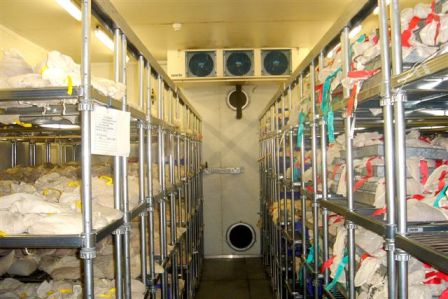 Controlled environment facility for germplasm seed drying at ICRISAT (photo: ICRISAT) |
- Dehumidified drying (temperature 15-20ºC and RH 15%) and silica gel drying.
IPK (Gatersleben, Germany) uses procedures based on requirements of the IPK quality management system (DIN EN ISO 9001:2000):
- Computer controlled drying chamber.
Drying time
According to procedures of the ICRISAT Genebank Manual (Upadhyaya and Laxmipathi, 2009):
- Depends on size of samples, initial moisture content and method of drying – usually one to four weeks.
Moisture content before drying
According to procedures of FAO/IPGRI Standards, as well as the ICRISAT Genebank Manual (Upadhyaya and Laxmipathi, 2009):
- About 8-12% (based on practical experience).
Moisture content for storage
- 8-10% for active collection and 5-7% for base collections.
Critical moisture content
The equilibrium relationship between seed moisture content and RH for chickpea storage is described in the ICRISAT Genebank Manual (Upadhyaya and Laxmipathi, 2009).
- It can vary between 3 and 7%.
Recording information during seed cleaning and drying
The following information should be recorded for each processing step:
- Accession identifier; National identity; Alternative identity (unique identification of the accession).
- Reference to seed source (to trace the origin of the sample).
- Seed moisture at harvest (% of moisture content of samples collected during harvesting.
- Threshing method employed.
- Drying method employed.
- Plot yield (g) (harvested seed yield).
- Seed samples moisture % after drying.
- Purity (%).
- Seed quantity (g) (cleaned seed yield).
- 100-seed weight (g) (weight of 100 randomly selected seeds).
- Germination % (seed germination from a standard test).
- Date of storage (date, month, year as dd/mm/yyyy).
- *Photographic record of seeds for each accession (100 seeds in petri dish with ID label).
- Remarks (any other information).
* This could be restricted to being done once, during characterization and does not need to be repeated at every regeneration cycle.
Determination of seed moisture content
Methods
According to the ISTA Standards:
- Use a high, constant temperature oven-drying.
Sampling frequency
This is important to cover the diversity in the accessions especially the seed traits.
- 5% of total number of seed samples/accessions.
- Or a minimum of ten accessions.
Sample size
According to the ISTA Standards:
- Use two replicates of 1.5-2.0 g of seeds.
Grinding
According to the ISTA Standards:
- It is recommended to coarse grind the samples.
Oven drying temperature
According to the ISTA Standards:
- 130±2ºC for one hour.
Others
According to the ISTA Standards:
- Use two replicates per sample.
Recording information during determination of seed moisture content
The following information should be recorded for each step:
- Accession number (unique identification of the accession).
- Replication number.
- W1 [weight of empty dish (g)].
- W2 [weight of dish + fresh sample (g)].
- W3 [weight of dish + dried sample (g)].
- Drying temperature.
- Time and date.
- (W2-W3)/(W2-W1) x100 [% of moisture content (on wet basis) of the replication].
- Mean moisture content (%) of the replications.
- Additionally, data field names are mentioned in Handling Seed in Genebanks (Hanson 1985) and Manual of Seed Handling in Genebanks (Rao et al., 2006).
References and further reading
Chakrabarty SK, Anitha K, Girish AG, Sarath BB, Prasada RRDVJ, Varaprasad KS, Khetarpal RK, Thakur RP. 2005. Germplasm Exchange and Quarantine of ICRISAT Mandate Crops. Information Bulletin No. 69. Rajendranagar 500 030, Andhra Pradesh, India: National Bureau of Plant Genetic Resources; and Patancheru 502 324, Andhra Pradesh, India: International Crops Research Institute for the Semi-Arid Tropics. 80 pp. ISBN 92-9066-481-9.
FAO/IPGRI. 1994. Genebank standards. Food and Agriculture Organization of the United Nations, Rome and International Plant Genetic Resources Institute, Rome. Available in English, Spanish, French and Arabic.
Hanson J. 1985. Procedures for handling seeds in genebanks. Practical manuals for genebanks no. 1. International Board for Plant Genetic Resources, Rome. http://www.bioversityinternational.org/index.php?id=19&user_bioversitypublications_pi1[showUid]=2235.
ISTA. 1993. International rules for seed testing. International Seed Testing Association. Bassersdorf, Switzerland. Seed Science and Technology 21 (Supplement):1-288.
ISTA. 2003. International rules for seed testing. International Seed Testing Association. Bassersdorf, Switzerland.
ISTA. 2005. International rules for seed testing. International Seed Testing Association. Bassersdorf, Switzerland.
Rao NK, Hanson J, Dulloo ME, Ghosh K, Nowel D, Larinde M. 2006. Manual of seed handling in genebanks. Handbooks for Genebanks No. 8. Bioversity International, Rome, Italy. Available in English (1.5 MB), Spanish (1.4 MB) and French (1.9 MB).
Stoyanova SD. 1992. Drying chickpea seeds for long-term preservation in genebanks. PGR-Newsletter 90:19-27.
Upadhyaya HD, Laxmipathi Gowda CL. 2009. Managing and Enhancing the Use of Germplasm – Strategies and Methodologies. Technical Manual no. 10. Patancheru 502 324, Andhra Pradesh, India: International Crops Research Institute for the Semi-Arid Tropics. 236 pp.
More Articles...
- Viability of cultivated chickpea and wild relatives genetic resources
- Health diagnosis of cultivated chickpea and wild relatives
- Storage of cultivated chickpea and wild relatives genetic resources
- Distribution of cultivated chickpea and wild relatives genetic resources
- Characterization of cultivated chickpea and wild relatives
Subcategories
-
Regeneration
- Article Count:
- 3
-
main
- Article Count:
- 1
-
Safety duplication
- Article Count:
- 1
-
Conservation
- Article Count:
- 7
-
Characterization
- Article Count:
- 1





